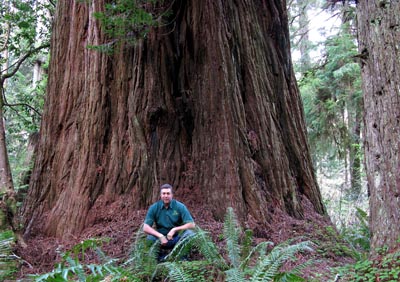 Overview
Overview
The gymnosperms are a group of seed bearing, vascular plants including conifers (the most abundant), cycads, gnetales,and ginkgo. There is currently an estimate of 900 gymnosperm species in existence. They first came about roughly 360 million years ago with the first species resembling ferns, but they have since diverged. The name Gymnosperm is Greek in origin, gymnospermos, which means naked seed, which of course is what defines a gymnosperm.
 Evolution
Evolution
From ferns, the main evolution of gymnosperm is the ability to bear seeds. The seeds are much more resistant than spores to enviormental conditions (which at the emergence of gymnosperms was arid). The seeds can also be carried by animals further distances and still thrive in different climates. The fertilized seeds can then wait untill conditions are optimum to germinate, unlike previously seen in ferns. Most gymnosperms are also heterosporus, with megasporangia and microsporangia that give rise to female and male gametophytes respectively. This allows for fertilization to occur within the same plant with only the aid of wind.
 Appearance
Appearance
Most gymnosperms have similar species across its composing phyla, but there are variances in certain aspects of each plant. The conifers are mainly trees with fully operation roots, a large woody body with several male and female cones on smaller branches, and needle like megaphylls that perform photosynthesis.
Cycads look like palm trees with an extremely large cone usually located in the center of the plant. Ginkgo Biloba, the lone species in its phylum, is tree, that is homosexual, has fan shaped leaves, with only two veins. Gnetophyte vary greatly across the 3 genera comprising their phylum, some appear as shrubs, while others have a single stem with many leaves branching out.
Life cycle
 Gymnosperms follow a similar life cycle that start with the sporophyte-the actual plant, such as the pine tree. Most species are heterosporous meaning there are both pollen and ovulate cones. In the pollen cone, microsporocytes undergo meiosis to become haploid microspores that then become pollen grains-the male gametophyte. The same happens in the ovulate cone, the surviving megospores become female gametophyte. Through wind aid, the
Gymnosperms follow a similar life cycle that start with the sporophyte-the actual plant, such as the pine tree. Most species are heterosporous meaning there are both pollen and ovulate cones. In the pollen cone, microsporocytes undergo meiosis to become haploid microspores that then become pollen grains-the male gametophyte. The same happens in the ovulate cone, the surviving megospores become female gametophyte. Through wind aid, the
grains of pollen coat ovulate cone. A pollen grain then penetrates the micropyle (entrance into the fluid which contains the megaspore)
The pollen grain germinates as the pollen tube develops and the female gametophyte develops with 2 to 3 archegonia each with an egg. When the egg matures, the pollen tube fully develops thus meeting the egg and sperm for fertilization. The embryo then develops into a seed with a food source and seed coat. The seed in time germinates into a mature sporophyte.
Uses and Importance
- The primary source of lumber as they are among the largest of all trees
- furniture and other home decor
- Railroad ties
- boxes and crates
- timber-plywood, 2x4s
- Paper products
- Medicinal Remedies
- Christmas trees
Seedless vascular plants gymnosperms Angiosperms
Comments (0)
You don't have permission to comment on this page.